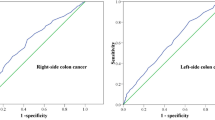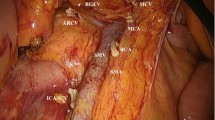Abstract
Purpose
Main lymph node metastasis (LNM) dissection of transverse colon (TC) cancer is a difficult surgical procedure. Nonetheless, the main LNM ratio and the benefit of main lymph node (LN) dissection in TC cancer were unclear. This study aimed to identify high-risk patients for LNM and to evaluate the benefit of LN dissection in TC cancer.
Methods
Data for 26,552 colorectal cancer patients between 2007 and 2011 were obtained from the JSCCR database. Of these, 871 stage I–III TC cancer patients underwent surgery with radical LN dissection. These patients were evaluated using the index of estimated benefit from lymph node dissection (IEBLD), where IEBLD = (LNM ratio of each LN station) × (5-year overall survival (OS) rate of the patients with LNM) × 100.
Results
None of the patients with depth of invasion pT1–2 had main LNM. The presence of main LNM was associated with depth of invasion pT4, CEA-4H (carcinoembryonic antigen 4 times higher than preoperative cutoff value), or type 3, and 323 patients (37.1%) who had these factors were high-risk patients for main LNM. In these high-risk patients, the LNM ratio, 5-year OS rate of patients with LNM and IEBLD values, respectively, were 43.9%, 70.3%, and 30.5 for the pericolic LN; 20.3%, 66.0%, and 15.1 for the intermediate LN; and 9.6%, 58.5%, and 5.6 for the main LN.
Conclusion
Main LNM is associated with depth of invasion pT4, CEA-4H, or type 3. The IEBLD for the main LN of high-risk TC cancer patients was over 5.




Similar content being viewed by others
References
Torre LA, Bray F, Siegel RL, Ferlay J, Lortet-Tieulent J, Jemal A (2015) Global cancer statistics, 2012. CA Cancer J Clin 65(2):87–108. https://doi.org/10.3322/caac.21262
Kanemitsu Y, Shida D, Tsukamoto S et al (2019) Nomograms predicting survival and recurrence in colonic cancer in the era of complete mesocolic excision. BJS Open 3(4):539–548. https://doi.org/10.1002/bjs5.50167
Karachun A, Petrov A, Panaiotti L, Voschinin Y, Ovchinnikova T (2019) Protocol for a multicentre randomized clinical trial comparing oncological outcomes of D2 versus D3 lymph node dissection in colonic cancer (COLD trial). BJS Open 3(3):288–298. https://doi.org/10.1002/bjs5.50142
Japanese Society for Cancer of the C, Rectum (2019) Japanese classification of colorectal, appendiceal, and anal carcinoma: the 3d English edition [secondary publication]. J Anus Rectum Colon 3(4):175–195. https://doi.org/10.23922/jarc.2019-018
Karachun A, Panaiotti L, Chernikovskiy I et al (2020) Short-term outcomes of a multicentre randomized clinical trial comparing D2 versus D3 lymph node dissection for colonic cancer (COLD trial). Br J Surg 107(5):499–508. https://doi.org/10.1002/bjs.11387
Alsabilah J, Kim WR, Kim NK (2017) Vascular structures of the right colon: incidence and variations with their clinical implications. Scand J Surg 106(2):107–115. https://doi.org/10.1177/1457496916650999
Yano M, Okazaki S, Kawamura I et al (2020) A three-dimensional computed tomography angiography study of the anatomy of the accessory middle colic artery and implications for colorectal cancer surgery. Surg Radiol Anat 42(12):1509–1515. https://doi.org/10.1007/s00276-020-02511-w
Cheruiyot I, Cirocchi R, Munguti J et al (2021) Surgical anatomy of the accessory middle colic artery: a meta-analysis with implications for splenic flexure cancer surgery. Colorectal Dis 23(7):1712–1720. https://doi.org/10.1111/codi.15630
Washio M, Yamashita K, Niihara M, Hosoda K, Hiki N (2020) Postoperative pancreatic fistula after gastrectomy for gastric cancer. Ann Gastroenterol Surg 4(6):618–627. https://doi.org/10.1002/ags3.12398
Sasako M, McCulloch P, Kinoshita T, Maruyama K (1995) New method to evaluate the therapeutic value of lymph node dissection for gastric cancer. Br J Surg 82(3):346–351. https://doi.org/10.1002/bjs.1800820321
Hohenberger W, Weber K, Matzel K, Papadopoulos T, Merkel S (2009) Standardized surgery for colonic cancer: complete mesocolic excision and central ligation--technical notes and outcome. Colorectal Dis 11(4):354–364; discussion 64-5. https://doi.org/10.1111/j.1463-1318.2008.01735.x
West NP, Kobayashi H, Takahashi K et al (2012) Understanding optimal colonic cancer surgery: comparison of Japanese D3 resection and European complete mesocolic excision with central vascular ligation. J Clin Oncol 30(15):1763–1769. https://doi.org/10.1200/JCO.2011.38.3992
Xu L, Su X, He Z et al (2021) Short-term outcomes of complete mesocolic excision versus D2 dissection in patients undergoing laparoscopic colectomy for right colon cancer (RELARC): a randomised, controlled, phase 3, superiority trial. Lancet Oncol 22(3):391–401. https://doi.org/10.1016/S1470-2045(20)30685-9
Olofsson F, Buchwald P, Elmstahl S, Syk I (2016) No benefit of extended mesenteric resection with central vascular ligation in right-sided colon cancer. Colorectal Dis 18(8):773–778. https://doi.org/10.1111/codi.13305
Yamashita H, Seto Y, Sano T et al (2017) Results of a nation-wide retrospective study of lymphadenectomy for esophagogastric junction carcinoma. Gastric Cancer 20(Suppl 1):69–83. https://doi.org/10.1007/s10120-016-0663-8
Japanese Gastric Cancer A (2011) Japanese classification of gastric carcinoma: 3rd English edition. Gastric Cancer 14(2):101–112. https://doi.org/10.1007/s10120-011-0041-5
Ueno H, Mochizuki H, Hashiguchi Y et al (2007) Potential prognostic benefit of lateral pelvic node dissection for rectal cancer located below the peritoneal reflection. Ann Surg 245(1):80–87. https://doi.org/10.1097/01.sla.0000225359.72553.8c
Miyamoto Y, Hiyoshi Y, Tokunaga R et al (2020) Postoperative complications are associated with poor survival outcome after curative resection for colorectal cancer: a propensity-score analysis. J Surg Oncol 122(2):344–349. https://doi.org/10.1002/jso.25961
Mima K, Miyanari N, Morito A et al (2020) Frailty is an independent risk factor for recurrence and mortality following curative resection of stage I-III colorectal cancer. Ann Gastroenterol Surg 4(4):405–412. https://doi.org/10.1002/ags3.12337
Sawayama H, Miyamoto Y, Hiyoshi Y et al (2021) Preoperative transferrin level is a novel prognostic marker for colorectal cancer. Ann Gastroenterol Surg 5(2):243–251. https://doi.org/10.1002/ags3.12411
Acknowledgements
We thank the participants of the JSCCR registry.
Funding
This work was supported by JSPS KAKENHI (grant number 19K09199).
Author information
Authors and Affiliations
Contributions
Hiroshi Sawayama contributed to the study concept and design, acquisition of data, analysis and interpretation of the data, drafting of the manuscript, and statistical analysis. Yuji Miyamoto contributed to the study concept and design, acquisition of data, analysis and interpretation of the data, drafting of the manuscript, and statistical analysis. Katsuhiro Ogawa contributed to the analysis and interpretation of the data and drafting of the manuscript. Mayuko Ohuchi contributed to the analysis and interpretation of the data and drafting of the manuscript. Ryuma Tokunaga contributed to the analysis and interpretation of the data and drafting of the manuscript. Naoya Yoshida contributed to the analysis and interpretation of the data and drafting of the manuscript. Hirotoshi Kobayashi contributed to the acquisition of data and analysis and interpretation of the data. Kenichi Sugihara contributed to the critical revision of the manuscript for important intellectual content. Hideo Baba contributed to the study supervision.
Corresponding author
Ethics declarations
Disclosure of ethical statements
Approval of the research protocol: The study protocol was approved by the Institutional Review Board of Kumamoto University, Approval Nos. 2377 and 2378. All the hospitals disclosed information to the patients. The participating patients were excluded only when they specified that they were unwilling to participate. The items of the registry of the study and animal studies are not applicable.
Conflict of interest
The authors declare no competing interests.
Additional information
Publisher’s note
Springer Nature remains neutral with regard to jurisdictional claims in published maps and institutional affiliations.
Supplementary information
Supplementary Figure S1.
A. Kaplan–Meier survival curves for patients with depth of invasion pT4 (N= 256) according to the station of lymph node metastasis (LNM): pericolic LNs (A-1), intermediate LNs (A-2) and main LNs (A-3). B. Kaplan–Meier survival curves for patients with CEA-4H (N= 77) according to the station of LNM: pericolic LNs (B-1), intermediate LNs (B-2) and main LNs (B-3). C. Kaplan–Meier survival curves for patients with Type 3 (N= 64) according to the station of LNM: pericolic LNs (C-1), intermediate LNs (C-2) and main LNs (C-3). (PPT 231 kb)
Supplementary Figure S2.
A. Kaplan–Meier survival curve according to adjuvant chemothepray for Stage III TC patients. B. Kaplan–Meier survival curve according to adjuvant chemothepray for theTC patients with main LNM. ACT; adjuvant chemotepray. (PPT 122 kb)
Supplementary Figure S3.
Kaplan–Meier survival curve according to surgical procedure (N=809). Data on surgical procedure were unavailable for 62 patients. (PPT 115 kb)
ESM 4
(DOCX 50 kb)
Rights and permissions
About this article
Cite this article
Sawayama, H., Miyamoto, Y., Ogawa, K. et al. Index of estimated benefit from lymph node dissection for stage I–III transverse colon cancer: an analysis of the JSCCR database. Langenbecks Arch Surg 407, 2011–2019 (2022). https://doi.org/10.1007/s00423-022-02525-5
Received:
Accepted:
Published:
Issue Date:
DOI: https://doi.org/10.1007/s00423-022-02525-5




